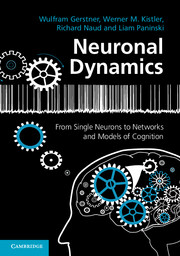Book contents
- Frontmatter
- Contents
- Preface
- PART ONE FOUNDATIONS OF NEURONAL DYNAMICS
- PART TWO GENERALIZED INTEGRATE-AND-FIRE NEURONS
- PART THREE NETWORKS OF NEURONS AND POPULATION ACTIVITY
- PART FOUR DYNAMICS OF COGNITION
- 16 Competing populations and decision making
- 17 Memory and attractor dynamics
- 18 Cortical field models for perception
- 19 Synaptic plasticity and learning
- 20 Outlook: dynamics in plastic networks
- References
- Index
18 - Cortical field models for perception
Published online by Cambridge University Press: 05 August 2014
- Frontmatter
- Contents
- Preface
- PART ONE FOUNDATIONS OF NEURONAL DYNAMICS
- PART TWO GENERALIZED INTEGRATE-AND-FIRE NEURONS
- PART THREE NETWORKS OF NEURONS AND POPULATION ACTIVITY
- PART FOUR DYNAMICS OF COGNITION
- 16 Competing populations and decision making
- 17 Memory and attractor dynamics
- 18 Cortical field models for perception
- 19 Synaptic plasticity and learning
- 20 Outlook: dynamics in plastic networks
- References
- Index
Summary
The world is continuous. Humans walk along corridors and streets, move their arms, turn their head, and orient the direction of gaze. All of these movements and gestures can be described by continuous variables such as position, head direction, gaze orientation, etc. These continuous variables need to be represented in the brain. Field models are designed to encode such continuous variables.
Objects such as houses, trees, cars, pencils have a finite extension in three-dimensional space. Visual input arising from these and other objects is projected onto the retinal photoreceptors and gives rise to a two-dimensional image in the retina. This image is already preprocessed by nerve cells in the retina and undergoes some further processing stages before it arrives in the cortex. A large fraction of the primary visual cortex is devoted to processing of information from the retinal area around the fovea. As a consequence, the activation pattern on the cortical surface resembles a coarse, deformed and distorted image of the object (Fig. 18.1). Topology is largely preserved so that neighboring neurons in the cortex process neighboring points of retinal space. In other words, neighboring neurons have similar receptive fields, which give rise to cortical maps; see Chapter 12.
- Type
- Chapter
- Information
- Neuronal DynamicsFrom Single Neurons to Networks and Models of Cognition, pp. 467 - 490Publisher: Cambridge University PressPrint publication year: 2014



